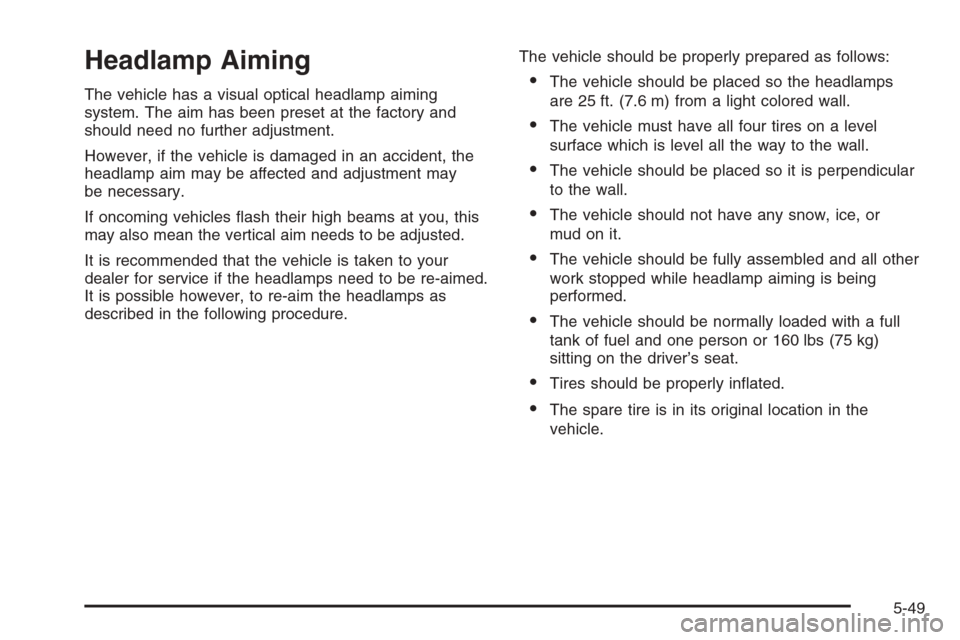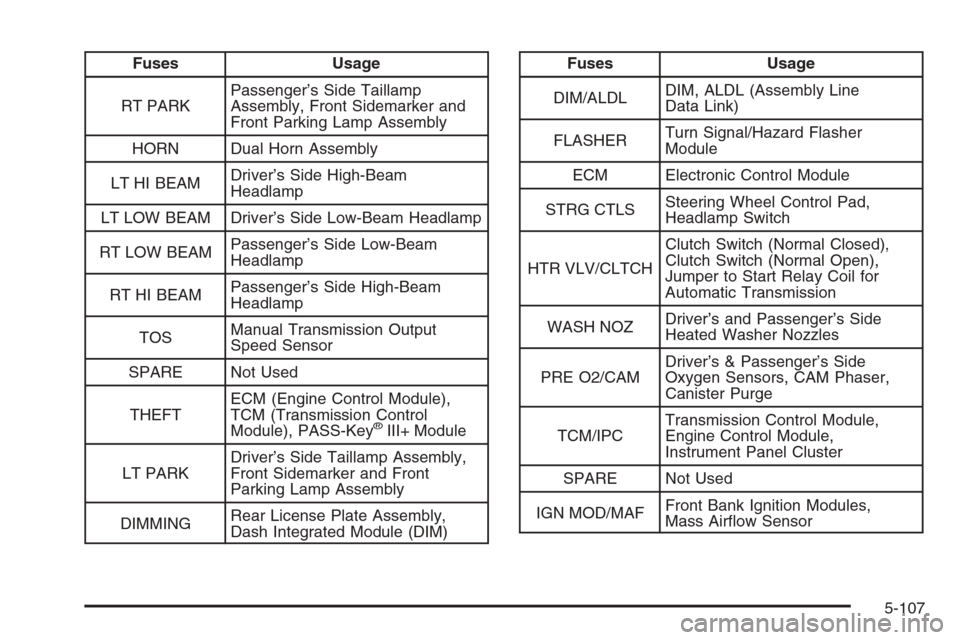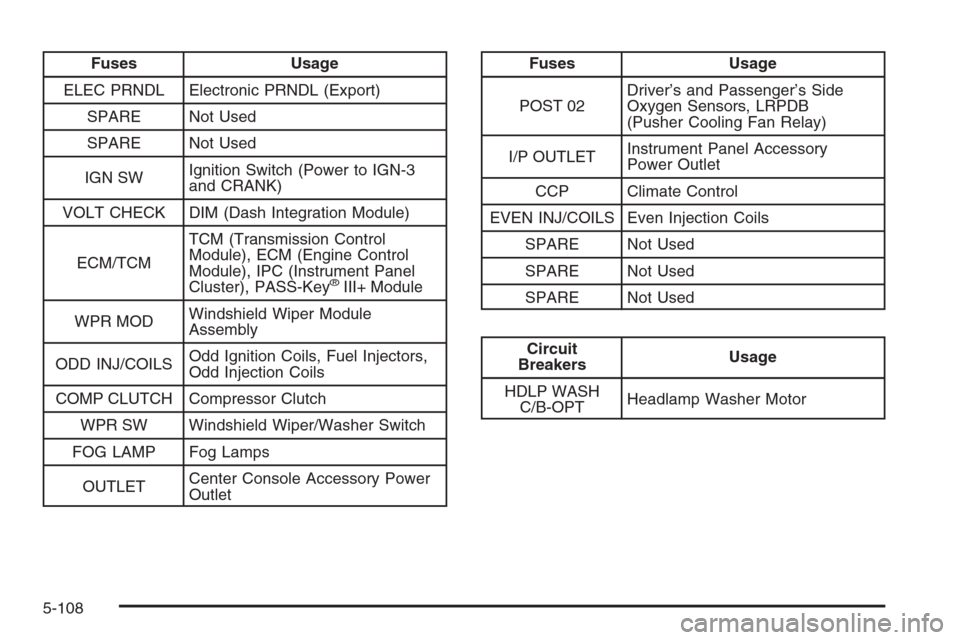headlamp CADILLAC CTS V 2006 1.G Owner's Manual
[x] Cancel search | Manufacturer: CADILLAC, Model Year: 2006, Model line: CTS V, Model: CADILLAC CTS V 2006 1.GPages: 442, PDF Size: 2.57 MB
Page 323 of 442

Headlamp Aiming
The vehicle has a visual optical headlamp aiming
system. The aim has been preset at the factory and
should need no further adjustment.
However, if the vehicle is damaged in an accident, the
headlamp aim may be affected and adjustment may
be necessary.
If oncoming vehicles �ash their high beams at you, this
may also mean the vertical aim needs to be adjusted.
It is recommended that the vehicle is taken to your
dealer for service if the headlamps need to be re-aimed.
It is possible however, to re-aim the headlamps as
described in the following procedure.The vehicle should be properly prepared as follows:The vehicle should be placed so the headlamps
are 25 ft. (7.6 m) from a light colored wall.
The vehicle must have all four tires on a level
surface which is level all the way to the wall.
The vehicle should be placed so it is perpendicular
to the wall.
The vehicle should not have any snow, ice, or
mudonit.
The vehicle should be fully assembled and all other
work stopped while headlamp aiming is being
performed.
The vehicle should be normally loaded with a full
tank of fuel and one person or 160 lbs (75 kg)
sitting on the driver’s seat.
Tires should be properly in�ated.
The spare tire is in its original location in the
vehicle.
5-49
Page 324 of 442

Headlamp aiming is done with the vehicle’s low-beam
headlamps. The high-beam headlamps will be correctly
aimed if the low-beam headlamps are aimed properly.
To adjust the vertical aim, do the following:
1. Open the hood. SeeHood Release on page 5-11
for more information.
2. Locate the aim dot on the lens of the low-beam
headlamp.
3. Measure the distance from the ground to the aim
dot on the low-beam headlamp. Record the
distance.4. At the wall measure from the ground upward (A) to
the recorded distance from Step 3 and mark it.
5. Draw or tape a horizontal line (B) the width of the
vehicle at the wall where it was marked it Step 4.
Notice:Do not cover a headlamp to improve beam
cut-off when aiming. Covering a headlamp may
cause excessive heat build-up which may cause
damage to the headlamp.
5-50
Page 325 of 442

6. Turn on the low-beam headlamps and place a
piece of cardboard or equivalent in front of the
headlamp not being aimed. This should allow
only the beam of light from the headlamp being
aimed to be seen on the �at surface.
7. Locate the vertical headlamp aiming screws, which
are under the hood near each headlamp assembly.
The adjustment screw can be turned with a
6 mm hex socket.8. Turn the vertical aiming screw until the headlamp
beam is aimed to the horizontal tape line. If you
turn it clockwise, it will raise the beam and if
you turn it counterclockwise, it will lower the beam.
The top edge of the cut-off should be positioned
at the bottom edge of the horizontal tape line.
9. Make sure that the light from the headlamp is
positioned at the bottom edge of the horizontal tape
line. The lamp on the left (A) shows the correct
headlamp aim. The lamp on the right (B) shows
the incorrect headlamp aim.
10. Repeat Steps 7 through 9 for the opposite
headlamp. Passenger’s Side Shown
5-51
Page 326 of 442

Bulb Replacement
For the proper type of replacement bulbs, see
Replacement Bulbs on page 5-55.
For any bulb changing procedure not listed in this
section, contact your dealer.
High Intensity Discharge (HID)
Lighting
{CAUTION:
The low beam high intensity discharge lighting
system operates at a very high voltage. If you
try to service any of the system components,
you could be seriously injured. Have your
dealer or a quali�ed technician service them.Your vehicle may have HID headlamps. After your
vehicle’s HID headlamp bulb has been replaced,
you may notice that the beam is a slightly different
shade than it was originally. This is normal.
Halogen Bulbs
{CAUTION:
Halogen bulbs have pressurized gas inside
and can burst if you drop or scratch the bulb.
You or others could be injured. Be sure to
read and follow the instructions on the bulb
package.
5-52
Page 351 of 442

Wheel Alignment and Tire Balance
The tires and wheels on your vehicle were aligned
and balanced carefully at the factory to give you
the longest tire life and best overall performance.
Adjustments to wheel alignment and tire balancing
will not be necessary on a regular basis. However,
if you notice unusual tire wear or your vehicle pulling to
one side or the other, the alignment may need to be
checked. If you notice your vehicle vibrating when
driving on a smooth road, your tires and wheels may
need to be rebalanced. See your dealer for proper
diagnosis.
Wheel Replacement
Replace any wheel that is bent, cracked, or badly
rusted or corroded. If wheel nuts keep coming loose,
the wheel, wheel bolts, and wheel nuts should be
replaced. If the wheel leaks air, replace it (except some
aluminum wheels, which can sometimes be repaired).
See your dealer if any of these conditions exist.
Your dealer will know the kind of wheel you need.
Each new wheel should have the same load-carrying
capacity, diameter, width, offset and be mounted
the same way as the one it replaces.If you need to replace any of your wheels, wheel
bolts, or wheel nuts, replace them only with new
GM original equipment parts. This way, you will be
sure to have the right wheel, wheel bolts, and wheel
nuts for your vehicle.
{CAUTION:
Using the wrong replacement wheels, wheel
bolts, or wheel nuts on your vehicle can be
dangerous. It could affect the braking and
handling of your vehicle, make your tires lose
air and make you lose control. You could have
a collision in which you or others could be
injured. Always use the correct wheel, wheel
bolts, and wheel nuts for replacement.
Notice:The wrong wheel can also cause problems
with bearing life, brake cooling, speedometer or
odometer calibration, headlamp aim, bumper height,
vehicle ground clearance, and tire or tire chain
clearance to the body and chassis.
SeeChanging a Flat Tire (CTS Only) on page 5-84for
more information.
5-77
Page 380 of 442

Relays Usage
HI BEAM RELAY
MICROHigh-Beam Headlamps
DRL RELAY
MICRO-OPTDaytime Running Lamps
LO BEAM
RELAY/HID
MINI-OPTLow-Beam HID Headlamps
HDLP WASH
RELAY
MINI-OPTHeadlamp Washer Motor
SPARE Not Used
BLOWER
RELAY MINIFront Blower
FOG LAMP
RELAY MICROFog Lamps
MAIN RELAY
MICROPowertrain/ECM
STARTER
RELAY MINIStarter Solenoid
CMP CLU RELAY
MICROCompressor Clutch
IGN-1 RELAY
MICROIgnition Switch (ON)Wiring
Harnesses Usage
BODY W/H Wiring Harness Connection
BODY W/H Wiring Harness Connection
ENG W/H Engine Wiring Harness Connection
J Cases Usage
R REARRRPDB (Passenger’s Side Rear
Power Distribution Box)
R REARRRPDB (Passenger’s Side Rear
Power Distribution Box)
L REARLRPDB (Driver’s Side Rear
Power Distribution Box)
L REARLRPDB (Driver’s Side Rear
Power Distribution Box)
HI FAN High Cooling Fan Motor
LO FAN Low Cooling Fan Motor
BLOWER PWM Fan Motor Assembly
STARTER Starter Solenoid
ABS Anti-Lock Brake System
5-106
Page 381 of 442

Fuses Usage
RT PARKPassenger’s Side Taillamp
Assembly, Front Sidemarker and
Front Parking Lamp Assembly
HORN Dual Horn Assembly
LT HI BEAMDriver’s Side High-Beam
Headlamp
LT LOW BEAM Driver’s Side Low-Beam Headlamp
RT LOW BEAMPassenger’s Side Low-Beam
Headlamp
RT HI BEAMPassenger’s Side High-Beam
Headlamp
TOSManual Transmission Output
Speed Sensor
SPARE Not Used
THEFTECM (Engine Control Module),
TCM (Transmission Control
Module), PASS-Key
®III+ Module
LT PARKDriver’s Side Taillamp Assembly,
Front Sidemarker and Front
Parking Lamp Assembly
DIMMINGRear License Plate Assembly,
Dash Integrated Module (DIM)
Fuses Usage
DIM/ALDLDIM, ALDL (Assembly Line
Data Link)
FLASHERTurn Signal/Hazard Flasher
Module
ECM Electronic Control Module
STRG CTLSSteering Wheel Control Pad,
Headlamp Switch
HTR VLV/CLTCHClutch Switch (Normal Closed),
Clutch Switch (Normal Open),
Jumper to Start Relay Coil for
Automatic Transmission
WASH NOZDriver’s and Passenger’s Side
Heated Washer Nozzles
PRE O2/CAMDriver’s & Passenger’s Side
Oxygen Sensors, CAM Phaser,
Canister Purge
TCM/IPCTransmission Control Module,
Engine Control Module,
Instrument Panel Cluster
SPARE Not Used
IGN MOD/MAFFront Bank Ignition Modules,
Mass Air�ow Sensor
5-107
Page 382 of 442

Fuses Usage
ELEC PRNDL Electronic PRNDL (Export)
SPARE Not Used
SPARE Not Used
IGN SWIgnition Switch (Power to IGN-3
and CRANK)
VOLT CHECK DIM (Dash Integration Module)
ECM/TCMTCM (Transmission Control
Module), ECM (Engine Control
Module), IPC (Instrument Panel
Cluster), PASS-Key
®III+ Module
WPR MODWindshield Wiper Module
Assembly
ODD INJ/COILSOdd Ignition Coils, Fuel Injectors,
Odd Injection Coils
COMP CLUTCH Compressor Clutch
WPR SW Windshield Wiper/Washer Switch
FOG LAMP Fog Lamps
OUTLETCenter Console Accessory Power
Outlet
Fuses Usage
POST 02Driver’s and Passenger’s Side
Oxygen Sensors, LRPDB
(Pusher Cooling Fan Relay)
I/P OUTLETInstrument Panel Accessory
Power Outlet
CCP Climate Control
EVEN INJ/COILS Even Injection Coils
SPARE Not Used
SPARE Not Used
SPARE Not Used
Circuit
BreakersUsage
HDLP WASH
C/B-OPTHeadlamp Washer Motor
5-108
Page 385 of 442

Rear Underseat Fuse Block
(Driver’s Side)
The driver’s side rear fuse block is located under
the rear seat on the driver’s side of the vehicle. The
rear seat cushion must be removed to access the rear
fuse block. See “Removing the Rear Seat Cushion”
listed previously.
To access the fuse block, push in the two tabs located at
each end of the fuse block cover. Then lift the cover off.
Fuses Usage
SPARE Not Used
SPARE Not Used
AUDIO Radio, OnStar Module
SPARE Not Used
REAR DR MOD Rear Door Modules
Fuses Usage
SPARE Not Used
DRIVER
DR MODDriver’s Door Module
BASTaillamps, Center High-Mounted
Stoplamp, Flasher Module,
ABS Module, Trailer Lamps
HDLP
LEVELINGHeadlamp Leveling System
Chassis Sensors (Export Only)
SPARE Not Used
CCP CCP (Climate Control Panel)
IGN 3Heated Seat Modules, Air Inlet
Motor, Shifter Assembly
SPARE Not Used
SPARE Not Used
FUSE PULLER Fuse Puller
L FRT HTD
SEAT MODDriver’s Heated Seat Module
MEM/ADAPT
SEATDriver’s Power Seat Switch
Memory Seat Module
TRUNK
DR RELEASETrunk Release Motor
5-111
Page 430 of 442

Audio System(s) (cont.)
Radio with CD............................................3-85
Setting the Time..........................................3-85
Theft-Deterrent Feature...............................3-101
Understanding Radio Reception...................3-102
XM™ Satellite Radio Antenna System...........3-104
Automatic Transmission
Fluid..........................................................5-23
Operation...................................................2-27
B
Battery..........................................................5-41
Exterior Lighting Battery Saver......................3-20
Before Leaving on a Long Trip.........................4-24
Brake
Anti-Lock Brake System (ABS)........................ 4-7
Emergencies................................................ 4-9
Panic Assist................................................4-13
Parking......................................................2-33
System Warning Light..................................3-38
Brakes..........................................................5-38
Braking........................................................... 4-6
Braking in Emergencies..................................... 4-9
Break-In, New Vehicle.....................................2-22
Bulb Replacement...........................................5-52
Back-Up and License Plate Lamps.................5-54
Front Turn Signal and Fog Lamps..................5-53
Halogen Bulbs............................................5-52Bulb Replacement (cont.)
Headlamp Aiming........................................5-49
High Intensity Discharge (HID) Lighting...........5-52
Replacement Bulbs......................................5-55
Taillamps, Turn Signal, Stoplamps and
Sidemarker Lamps...................................5-53
Buying New Tires...........................................5-73
C
Calibration.....................................................2-39
California Fuel.................................................. 5-6
California Proposition 65 Warning....................... 5-3
Canadian Owners................................................ ii
Capacities and Speci�cations..........................5-115
Carbon Monoxide...................2-12, 2-37, 4-27, 4-39
Care of
Safety Belts................................................5-97
Your CD Player.........................................3-104
Your CDs .................................................3-103
Center Console Storage Area...........................2-49
Chains, Tire...................................................5-78
Charging System Light....................................3-37
Check
Engine Light...............................................3-41
Engine Oil Pressure Message.......................3-51
Checking Things Under the Hood......................5-10
Chemical Paint Spotting.................................5-101
2